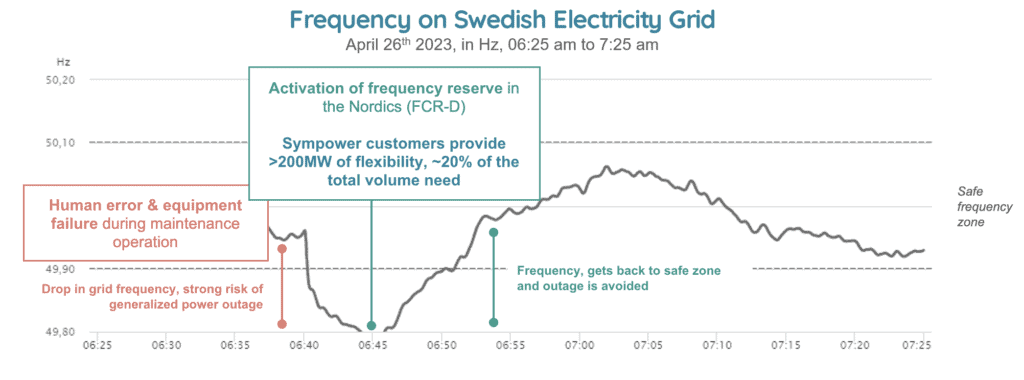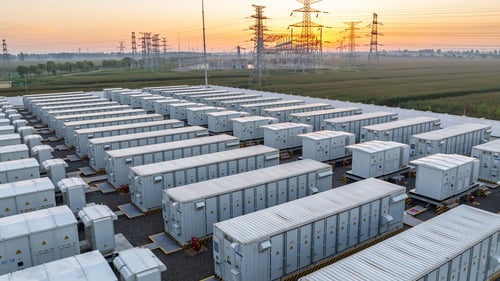Five Times Demand Response Saved the Grid
.jpg?width=768&name=Article%20Thumbnails%20-%201920x1080%20new%20website%20(6).jpg)
While demand response programmes are relatively new players in the global energy sector, they are already recognised as a vital tool in the energy transition. As we increasingly rely on renewable energy sources to power the grid, demand response will play a crucial role in averting potential grid failures and addressing supply and demand imbalances.
Demand response has saved the grid several times in European countries that have invested in establishing demand response initiatives to manage and maintain grid stability.
Here are five times demand response saved the grid - and the day.
Unlock New Revenue Streams with Demand Response
Check out our essential guide to energy flexibility.
Jump to:
- Sweden, 2023
- Finland, November 2023
- France, 2021
- Germany, 2019
- Ireland, 2018
- More benefits of demand response
Sweden, April 2023
In April of 2023, the Swedish grid experienced electricity supply disturbances in Stockholm’s area due to a power outage during maintenance work in the principal grid station. To properly function, grid frequency must stay within the range of 49.90 to 50.10 Hz. It dropped to 49.296 Hz during the outage, causing a severe risk of a generalised power outage (blackout).

Source: Svenka Kraftnat
Two nuclear power plants were disconnected from the grid to protect the infrastructure, equipment and systems from damage, removing around 2GW of power generation from the grid. Restoring the affected power systems and grid infrastructure can take time following a disruption of this size.
Enters demand response.
After the disconnection of the two nuclear power blocks, Sympower’s grid balancing services deployed over 200MW of flexibility within seconds of the outage. This action, supported by Sympower’s Nordic partners, enabled a swift recovery by giving more time for a secondary system to step in and prevent large-scale blackouts across Sweden.
The disruption in the electricity supply in the Stockholm region reminds us of the importance of a robust and reliable infrastructure, as well as the need for quick actions in unexpected events. It highlighted the critical role of the frequency containment reserve market in ensuring the stability of the power grid and minimising the impact of disruptions on the society.
Grifin Hill, Operations Analyst, Sympower Sweden
Finland, November 2023
When Europe’s largest nuclear reactor, Olkiluoto 3, faced an unexpected technical problem and was disconnected from the grid, 1.6GW of nuclear generation was consequently lost. This incident caused a substantial grid frequency drop, reaching 49.60Hz - when in normal operations, it needs to remain between 49.90 to 50.10Hz to function properly.
The Frequency Containment Reserves for Disturbance (FCR-D) were then swiftly activated to prevent a large-scale blackout on the Nordic grid. The speed and reactivity of FCR providers are crucial in preserving the grid. As the primary control reserve, they act as the first protective layer to help restore the safety and security of the grid.
With the help of Nordic partners and customers, Sympower deployed over 100MW of flexibility within seconds.
As a service provider to the Transmission System Operators in the Nordics, we are the electrical system's first responders. We take initial care of the system during a disturbance before the slower-reacting process steps in. It's great to see that all our resources responded exactly as they should have when the incident occurred.
Emil Jonkvist, Partner Manager, Sympower
France, 2021
In January 2021, France faced a sudden shortage of electricity supply following unexpected nuclear reactor outages.
As a first response, the French grid operator RTE called for demand-response measures to balance and secure the grid. Industrial consumers reduced their electricity consumption, and some non-essential activities were temporarily paused or curtailed. These actions helped avoid power cuts and ensured France’s grid stability.
Activation of demand response capacity in France has increased significantly in recent years, with around 20GWh of demand response activated in 2021, almost twice as much as in 2020 and the highest since 2018. The most significant demand response activation happened in January of 2021 when stress on the electricity system, caused by the low availability of generating assets, led to reactor outages. This increase in capacity activation shows that RTE is increasingly recognising the reliability provided by demand response and its positive impact on the grid.
Germany, 2019
Another factor affecting the grid is extreme weather changes. In the summer of 2019, Germany experienced a series of severe heat waves, leading to a spike in electricity demand for cooling systems and appliances. This demand surge added much pressure on the grid and required the activation of demand response programmes during heat waves to guarantee a continuous electricity supply.
By incentivising consumers to adjust their electricity usage, the programme helped prevent grid overloads and potential blackouts.
Ireland, 2018
In 2018, Ireland faced an unexpected drop in wind power generation due to unseasonably calm weather conditions.
Irish grid operator EirGrid relied on demand response participants to reduce their electricity consumption to help balance the grid without wind generation.
Key players, such as high-energy consumers like industrial and commercial energy users, reacted by adjusting their operations and decreasing their electricity usage. As a result, this helped bring down overall demand and lessened the impact of the wind power shortage to maintain grid stability.
More Benefits of Demand Response
Just from these examples, it is clear that demand response and grid flexibility are crucial mechanisms to guarantee a steady electricity supply and prevent outages during critical situations.
Demand response programmes can become even more effective with increased participation from all sectors, from industrial to household consumers. In addition to being an essential part of the grid management toolkit, demand response services accelerate the clean energy transition by boosting electricity systems’ resilience and enabling cost savings for energy users.
Most companies can participate in demand response by unlocking the inherent flexibility of their existing assets.
Other articles you might find interesting
-
 Demand-side flexibility19 December 2023
Demand-side flexibility19 December 2023District Heating Operators: New Revenue From Grid Balancing
Read more -
 Demand-side flexibility19 December 2023
Demand-side flexibility19 December 2023Five Myths About Demand Response, Debunked!
Read more -
 Demand-side flexibility19 December 2023
Demand-side flexibility19 December 2023BESS & Demand Response, What’s the Connection?
Read more -
.jpg?length=500&name=Article%20Thumbnails%20-%201920x1080%20new%20website%20(4).jpg) Demand-side flexibility19 December 2023
Demand-side flexibility19 December 20233 Things to Look for in a Flexibility Service Provider
Read more -
.jpg?length=500&name=Article%20Thumbnails%20-%201920x1080%20new%20website%20(35).jpg) Demand-side flexibility19 December 2023
Demand-side flexibility19 December 2023smartEn Executive Director Michael Villa on the future of energy flexibility in Europe
Read more -
.jpg?length=500&name=Article%20Thumbnails%20-%201920x1080%20new%20website%20(34).jpg) demand response19 December 2023
demand response19 December 2023Getting Europe’s Grids Fit for the 21st Century - Interview With SmartEn’s Executive Director Michael Villa
Read more -
 Demand-side flexibility19 December 2023
Demand-side flexibility19 December 2023Empowering Industry through Energy Flexibility - Q&A with Raphaël Gras
Read more -
 demand response19 December 2023
demand response19 December 2023EU elections: Opportunity or Risk for Demand-Side Flexibility? - Q&A with Mathilde Chareyron
Read more -
 Energy management19 December 2023
Energy management19 December 2023Going From Passive to Active as an Energy Consumer - Q&A with Gianluca Rimini
Read more -
.jpg?length=500&name=Article%20Thumbnails%20-%201920x1080%20new%20website%20(5).jpg) Knowledge19 December 2023
Knowledge19 December 2023How to Earn Revenue with Demand Response
Read more -
.jpg?length=500&name=Article%20Thumbnails%20-%201920x1080%20new%20website%20(9).jpg) Energy markets19 December 2023
Energy markets19 December 2023Why do Energy Prices Change?
Read more -
.jpg?length=500&name=Article%20Thumbnails%20-%201920x1080%20new%20website%20(12).jpg) electrification19 December 2023
electrification19 December 2023What are Energy Markets?
Read more